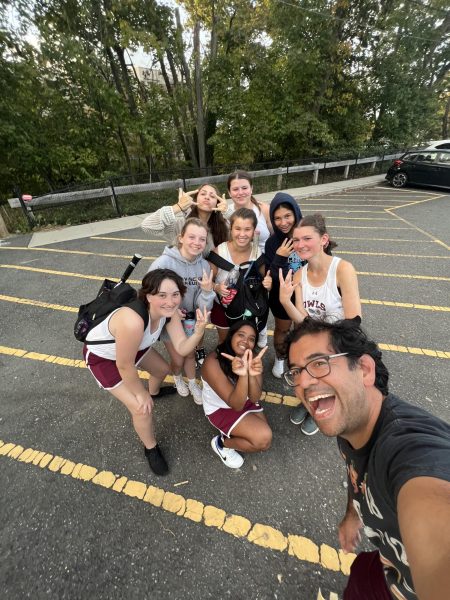Healthy Coping Mechanisms for Stress
Undoubtedly that many high school students deal with stress, and some with anxiety. The cause can be a variety of things from exams, homework, overall work, and/or external problems. We talked to Mr. Yeager, the Student Assistance Coordinator and Certified School Psychologist, for advice and techniques on how to handle stress and anxiety.
We did a short interview on Mr. Yeager to get a general understanding of stress and its effects.
Do you notice higher amounts of stress in students in more recent times?
“Yes, there are definitely higher levels of stress, and not just in Park Ridge. The Centers for Disease Control have seen a striking rise in teenage anxiety across the country. In fact, estimates all seem to converge around the fact that 20 to 25% of all teenagers will deal with some form of mental illness, and most of that is anxiety and depression. Stress is a major factor in both.”
What are some healthy coping mechanisms for stress?
“The best way to deal with stress is to prevent it in the first place. The best three ways to do this are proper sleep, healthy diet, and getting exercise. Dealing with stress once it’s occurring is best accomplished through time management, spending time with others for recreation, and specific relaxation exercises like the linked videos. And of course if stress or anxiety get really bad, one of the best ways of coping is to speak with a counselor.”
Do you think there are any effective changes or additions to the curriculum to decrease stress levels associated with school?
“Perhaps the best way to modify the curriculum would be to discuss these issues more directly. That would be stress in particular and overall mental health in general – including instruction on effective coping skills.”
Do you have any advice about how the student body can help each other deal with stress and anxiety?
“Recognizing that we all deal with stress is an important start. Many students feel like they are the only ones (or in a small minority) who are dealing with stress. That’s because we feel our own stress/anxiety much more than we can see it in someone else.
This might seem trite, but there is one strategy that most – if not all– students can adopt that would significantly reduce stress, enhance grades, sleep, and overall happiness: PUT DOWN YOUR CELL PHONE. Especially when studying. We are just beginning to understand the negative effects of excessive technology are lives. This is actually a friend/community issue because most of us do what our friends do so excessive use of social media, gaming, etc. are done because everybody does it but nobody specifically set the rules. People feel they can’t disengage from social Technology out of fear of missing out or appearing rude. If the entire group agrees to limit social technology for either mental health or study skills, people might feel more comfortable disengaging.”
When do you know you are dealing with anxiety and not regular everyday stress?
“There is no clear line distinguishing the two, but we look for frequency, intensity, and causation. In other words does the negative emotional state occur often, last for a long period of time, is experienced as particularly intense, and does the reaction correlate with specific life stressors or does it tend to happen even when there are no it excessive demands
What percentage of high school students in New Jersey deal with anxiety?
“I would say that the percentage of teens dealing with diagnosable anxiety disorder in Park Ridge are roughly the same as the national data: probably around 10 – 20% of the student body dealing with a major anxiety disorder. I would add that perhaps 50% or more of the student body will deal with periodic anxiety or stress that is significant enough to interfere with their ability to cope and be happy.”
A technique that he recommends is a short breathing exercise for various occasions. The first, for a calm body and an alert mind, it is 1 to 1 breathing. Inhale to whatever is comfortable, counting how long it takes, and then exhale to the same number. By doing this, each exhale is the same length, intensity, and duration as the inhale. Make sure not to make the breathing choppy and to keep a smooth rhythm. This breathing technique is beneficial to focus in a classroom or while taking a test as it keeps the body calm and keeps the mind alert. If you want to sleep, you do the 2 to 1 breathing technique. Inhale to whatever is comfortable and proceed to exhale for a longer length of time. It should be double the length of the inhale but it can be difficult based on how long the inhale was. As long as the exhale is longer than the inhale, it is 2 to 1 breathing. This taps into and stimulates the parasympathetic nervous system which promotes sleep. If you want to wake yourself up, you can do a couple of breaths with a slightly longer inhale than exhale. You would want to be careful with this because if done incorrectly and almost in a gasping manner, it can cause hyperventilating.
The topic of stress and healthy ways to deal with it is becoming prevalent among students and experts as more people are becoming aware of its effects. As a result of this, talking to experts and those who know what to do, like Mr. Yeager, can provide support for those who need it. They know many methods to cope with stress and other mental problems and are there if someone needs to talk.




